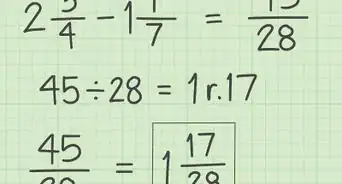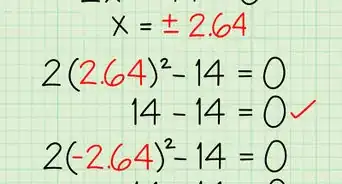X
wikiHow is a “wiki,” similar to Wikipedia, which means that many of our articles are co-written by multiple authors. To create this article, 17 people, some anonymous, worked to edit and improve it over time.
There are 10 references cited in this article, which can be found at the bottom of the page.
This article has been viewed 41,069 times.
Learn more...
Cancelling fractions is also called simplifying fractions. Basically, a fraction can be made simpler by dividing the top and bottom by the same number. Both the top and bottom must divide evenly for you to simplify the fraction. You can either find the greatest common factor to simplify the fraction or start simplifying by using prime numbers.
Steps
Method 1
Method 1 of 3:
Finding the Greatest Common Factor
-
1Understand what a factor is. A factor is one of the numbers that can be multiplied evenly by another number to get the third number. For instance, a factor of 6 is 2 because 2 times 3 equals 6.[1]
-
2Write out the factors of each number. The easiest way to write out all the factors is to begin with 1 and the number.[2]Advertisement
-
3Make a factor rainbow for the top number.[3] For instance, say the fraction is 14/28. The first two factors for 14 are 1 and 14. Place them an inch or so apart on a line. Connect them with an arch, so that you know that those two multiply together to make 14.
- Move inward, making a factor rainbow by making an arch with each set of factors.
- Divide by 2 next, which divides evenly because 2 multiplied by 7 equals 14. Therefore, the next two factors are 2 and 7. Connect those with an arch.
- However, 3 does not divide into 14 evenly, and neither does 4 or 5. At this point, you've reached the middle of the factor rainbow, so the factors are 1, 2, 7, and 14.
-
4Make a factor rainbow for the bottom number.[4] The first two factors for 28 are 1 and 28; connect those two with an arch.
- The next two are 2 and 14. Three does not divide evenly into 28. However, 4 does, so the next factors are 4 and 7. Neither 5 nor 6 divide evenly into 28, so you've reached the end of your factor rainbow for 28. Your factors are 1, 2, 4, 7, 14, and 28.
-
5Find the greatest common factor. The greatest common factor is the largest factor that both numbers share. For instance, in the two sets of factors you just found, 14 is shared between both sets, so it is the greatest common factor.[5]
Advertisement
Method 2
Method 2 of 3:
Simplifying the Fraction
-
1Write the fraction on a piece of paper. Place the 14 over the 28 with a line in between.
-
2Write out the equation. Place a division side to the right of each number. To the right of the division signs, place a 14 for each number. Put an equal sign to the right of the equation.[6]
-
3Divide out both numbers. Divide both 14 and 28 by 14. Fourteen divided by 14 is 1. Twenty-eight divided by 14 is 2.[7]
-
4Write out the answer as a fraction. To the right of the equal sign, right 1 above 2 with a line in between. Your final answer is 1/2.[8]
-
5Check your work. Multiply 1/2 by 14 on top and bottom to see if you get 14/28. One times 14 is 14, and 2 times 14 is 28. Your answer is correct.
Advertisement
Method 3
Method 3 of 3:
Guessing at Factors
-
1Decide on a number to divide by. For instance, you can choose 2 if both numbers are even.[9] Three is a good choice if you can add the digits together to a number divisible by three. For instance, 39 is divisible by 3 because 3 plus 9 equals 12, a number divisible by 3.
- Try only using prime numbers, such as 2, 3, 5, 7, and so on, and moving from the smallest to the largest.[10]
-
2Try dividing it into the fraction. Say the fraction is 18/63. Eighteen is divisible by 2, but 63 is not. You need to move to the next prime, 3. Both 18 and 63 are divisible by 3. Divide 3 into both numbers; 18 divided by 3 is 6, while 63 divided by 3 is 21. Therefore, your new fraction 6/21.[11]
-
3Simplify some more. Often, with this method, you'll need to simplify the fraction some more. Because 6/21 does not seem simplified, try dividing into it again. Both numbers are divisible by the same factor, 3. Six divided by 3 is 2, while 21 divided by 3 is 7. Your new fraction is 2/7.[12]
-
4Check for common factors other than 1. The factors of 2 are just 1 and 2. The factors of 7 are 1 and 7. Therefore, the numbers do not share any more common factors.[13]
-
5Check your answer. You used the factors 3 and 3. Multiply them together to get the greatest common factor for the original fraction, 9. Now, check your answer by multiplying each number in your final fraction by 9. Two times 9 is 18, while 7 times 9 is 63, making the fraction 18/63. Your answer checks out.
Advertisement
Community Q&A
-
QuestionWhat is 1/2 divided by 5/6?
 Community Answer1/2 divided by 5/6 is the same as 1/2 multiplied by 6/5, which is 6/10 or 3/5.
Community Answer1/2 divided by 5/6 is the same as 1/2 multiplied by 6/5, which is 6/10 or 3/5. -
QuestionWhat if it is 6/1 divided by 6/12?You can simplify 6/12 to 1/2, which makes the sum easier. From there you multiply by the inverse, in this case 6/1 × 2/1, which is 12/1 or just 12.
Advertisement
References
- ↑ https://www.mathsisfun.com/greatest-common-factor.html
- ↑ https://www.mathsisfun.com/greatest-common-factor.html
- ↑ https://www.khanacademy.org/math/cc-fourth-grade-math/imp-factors-multiples-and-patterns/imp-factors-and-multiples/v/finding-factors-of-a-number
- ↑ https://www.youtube.com/watch?v=vqYhXDFuF0M
- ↑ https://www.khanacademy.org/math/cc-sixth-grade-math/cc-6th-expressions-and-variables/cc-6th-gcf/v/greatest-common-divisor
- ↑ https://www.mathsisfun.com/simplifying-fractions.html
- ↑ https://www.mathsisfun.com/simplifying-fractions.html
- ↑ https://www.mathsisfun.com/simplifying-fractions.html
- ↑ https://www.youtube.com/watch?v=usxTJbQbAIg
- ↑ http://www.mathsisfun.com/simplifying-fractions.html
- ↑ https://www.khanacademy.org/math/cc-fourth-grade-math/imp-factors-multiples-and-patterns/imp-prime-and-composite-numbers/v/prime-numbers
- ↑ https://www.wtamu.edu/academic/anns/mps/math/mathlab/int_algebra/int_alg_tut34_complex.htm
- ↑ https://www.wtamu.edu/academic/anns/mps/math/mathlab/col_algebra/col_alg_tut7_factor.htm
About This Article
Advertisement










































































